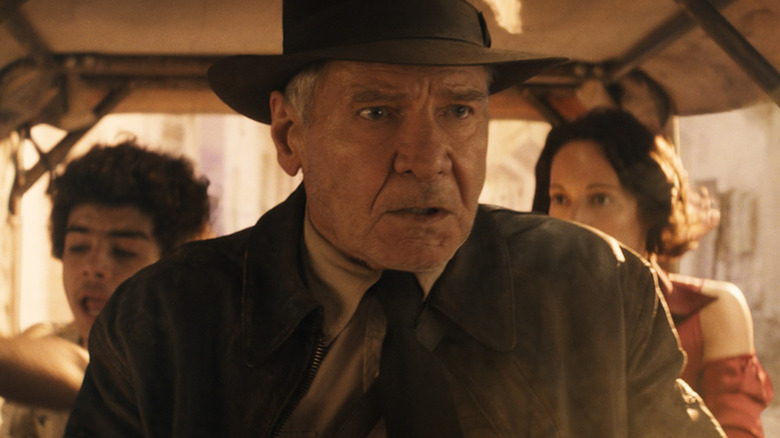[ad_1]
This post contains spoilers for “Indiana Jones and the Dial of Destiny.”
For the last two years, James Mangold has been living the fanboy dream. 40 years after the premiere of “Raiders of the Lost Ark,” the director of “Copland” and “Logan,” who was 18 when the film hit theaters, earned the honor of not only replacing Steven Spielberg behind the cameras on an Indiana Jones movie, but giving Harrison Ford’s adventuring archaeologist a proper, if deeply melancholy sendoff.
Being that Mangold is the man who killed Hugh Jackman’s Wolverine in the elegiac “Logan,” Indy fans speculated that the filmmaker was hired to perform the same function on “Indiana Jones and the Dial of Destiny.” In an interview with Entertainment Weekly, Mangold revealed that he was well aware of these expectations. “There was a lot of anxiety that I was just going to turn into the icon executioner,” he said.
Spoiler alert: Mangold spared Indy. Though it looks grim for a moment in the film’s climax, as Indy, having been shot for the tenth time in his life, asks his goddaughter Helena (Phoebe Waller-Bridge) to leave him with the Sicilian mathematician Archimedes in 212 B.C., he’s ultimately subdued (i.e. cold-cocked) and returned to his New York City apartment in 1969, where he reconciles with his estranged wife Marion (Karen Allen). And while Ford is adamant that this is his last time wielding the whip, the final shot of the film finds him playfully retrieving his fedora from a clothesline. Indy’s questing days may be over, but his inner-rascal will be making cheerful domestic trouble until he breathes his last.
Still, you can’t help but wonder if Mangold and his screenwriters considered launching Indy into the undiscovered country. Surely there was a temptation to do something a little more final.
It’s a sin to kill an archaeologist
According to James Mangold, killing Indiana Jones was never a realistic option. He explained the differences between “Logan” and “Dial of Destiny” to EW thusly:
“[T]here really is no attraction to just getting thousands of people in a theater and hitting them in a head with a hammer. […] Death is not an ending. The reason death worked in ‘Logan’ is because of the beautiful irony of his death, which is that he lived such a painful life, that it was only in the last 30 seconds of his life that he actually got to experience love. And that to me was what was so moving about that ending.”
For Indy, death did not feel like an emotionally satisfying ending. “It had to be about him coming to terms with this period of his life and this period of the world,” said Mangold. “And in a way, coming to terms with whether Indiana Jones has relevance to ours.”
I don’t know that Indy’s relevance to the world at large as a retired 80-year-old professor is clear at the end of the movie, but his purpose as a husband and grieving parent is absolutely established. When Marion walks into his apartment in the final scene and asks if he’s “back,” she needs to know if he’s done running into trouble and away from the sorrow of losing his son in (we assume) Vietnam. Did taking his tenth bullet and nearly dying on a Sicilian beach during the Siege of Syracuse wake him up to the reality of being a very old and terribly mortal man?
A fittingly quiet end to a rollicking saga
Paying tribute to the kiss-me-where-it-hurts scene from “Raiders of the Lost Ark” is a big, potentially mawkish swing, but it works beautifully because Marion has always been the love of Indy’s life. And let’s not lose sight of the franchise’s serial origins. No one ever wants to see the hero die. Frankly, we don’t want to see the hero get old, but when your serial homage turns into a billion-dollar undertaking, the success of which is contingent on one actor playing the lead role, you ride your star until the wheels fall off.
Harrison Ford’s history of injuries incurred on- and off-set is well documented. I cannot imagine how much he aches when he gets out of bed in the morning. Ford owns his busted-up physical state early in the movie, and it ain’t glamorous. But he displays the scars and atrophying muscle with pride. He’s showing us the years and the mileage. Simply being upright at Ford’s age is an accomplishment. Socking bad guys and riding a horse down a Manhattan subway track is inconceivable for most people at any point in their life.
Ford, through Indy, has sacrificed a ton for our enjoyment. James Mangold is right. We don’t want to watch his iconic protagonist die on screen. We just want to see him at rest. Thanks for the memories, and the bruises, Dr. Jones.
[ad_2]
Source link



